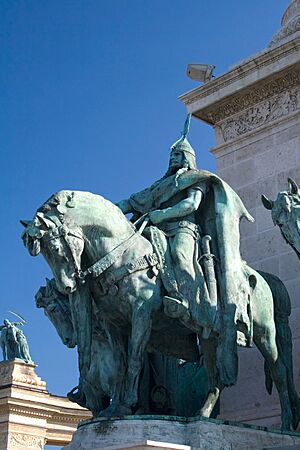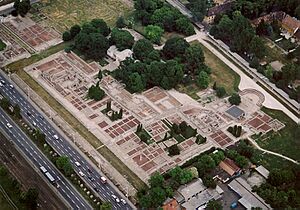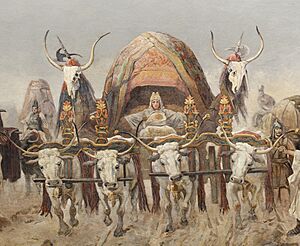Árpád facts for kids
Quick facts for kids Árpád |
|
|---|---|
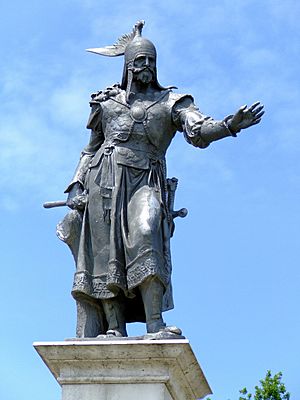
Statue of Árpád at Ráckeve (Hungary)
|
|
| Grand Prince of the Hungarians | |
| Reign | c. 895 – c. 907 |
| Predecessor | Álmos |
| Successor | Zoltán (uncertain) |
| Born | c. 845 |
| Died | c. 907 (aged 62) |
| Burial | Fehéregyháza (Hungary) (uncertain) |
| Issue | Liüntika Tarkatzus Jelek Jutotzas Zoltán |
| Dynasty | Árpád dynasty |
| Father | Álmos |
| Religion | Hungarian paganism |
Árpád (Hungarian pronunciation: [ˈaːrpaːd]) was a very important leader of the Magyar tribes. He lived around the late 800s and early 900s. People in Hungary often call him the "founder of our country."
Historians aren't completely sure about all the details of Árpád's life. This is because old writings sometimes disagree. He might have been a sacred ruler, called a kende, or a military leader, called a gyula. Either way, he played a huge role in the Hungarian conquest of the Carpathian Basin. This was when the Hungarians moved into their new homeland. Árpád's family, known as the Árpád dynasty, ruled the Kingdom of Hungary for many centuries, until 1301.
Contents
Biography of Árpád
Early Life and Leadership
Árpád was the son of Álmos, who was also a leader of the Magyar tribes. We don't know much about Árpád's mother. He was probably born around the year 845. His name comes from the Hungarian word for barley, árpa.
A Byzantine Emperor named Constantine VII wrote about Árpád. He said that before Árpád, the Hungarians never had another main leader. This is different from what Hungarian stories say about Árpád's father, Álmos.
Constantine wrote that the Khazars, a powerful group, wanted to unite the Hungarian tribes. They first suggested a chieftain named Levedi to lead them. But Levedi said no. He suggested that either Álmos or Árpád should be the leader instead. The Hungarians chose Árpád. They admired him for his wisdom, good advice, and bravery. He was made a prince by being lifted onto a shield. This was a custom of the Khazars.
Historians still discuss how accurate this story is. Some think it's not very clear. Others believe the main idea is true. They suggest that Árpád's father, Álmos, might have helped Árpád become the sacred ruler. This would have allowed Álmos to remain the military leader.
Moving Towards a New Homeland
The first clear historical record about Árpád comes from a document from the early 900s. It says that in 894 or 895, the Byzantine Emperor Leo VI sent a messenger to the Hungarians. He wanted them to fight against the First Bulgarian Empire.
The messenger met with two Hungarian leaders, Árpád and Kurszán, near the Danube River. Their mission worked. A Hungarian army soon crossed the Danube on Byzantine ships to attack Bulgaria. Some writings suggest that Árpád's son, Liüntika, led this army.
Historians also debate what roles Árpád and Kurszán had at this time. Some think Árpád was the military leader and Kurszán was the sacred ruler. Others believe Kurszán was the military leader, and Árpád represented his father, Álmos.
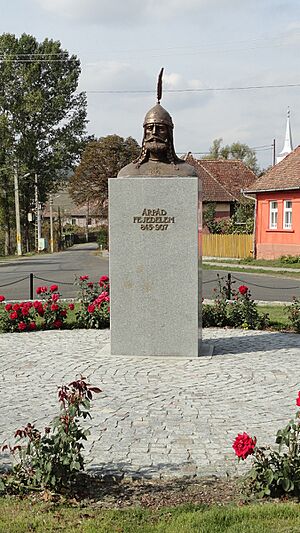
The Hungarian army defeated the Bulgarians. But the Bulgarians then hired another group, the Pechenegs, to fight the Hungarians. In 895 or 896, the Bulgarians and Pechenegs attacked the Hungarians' lands at the same time. This attack destroyed their homes. Because of this, the Hungarians had to leave. They moved across the Carpathian Mountains to find a new home in the Pannonian Plain. This big move is known as the Hungarian conquest of the Carpathian Basin.
Some old Hungarian stories say that Árpád's father, Álmos, was killed in Transylvania before they could enter their new land. Some historians think this might have been a ritual killing. This was sometimes done to leaders if a disaster happened to their people. Other historians disagree. They think if Álmos was killed, it might have been by Árpád or someone close to him. Another old story says that Álmos appointed Árpád as the new leader during a siege.
Árpád's Rule
Writings from other parts of Europe at that time, like East Francia, don't mention Árpád much. They mostly talk about another Hungarian leader, Kurszán. This makes some historians think that Kurszán was the main military leader. They believe Árpád became the sacred ruler after his father died. However, another idea is that Kurszán was the sacred ruler, and Árpád became the military leader after Kurszán was killed around 902 or 904.
However, Hungarian stories written much later, like the Gesta Hungarorum, strongly emphasize Árpád's important role. They say he led the conquest of the Carpathian Basin. The Gesta Hungarorum also describes Árpád as a skilled military leader and a generous person. It even says that one of the Hungarian tribal leaders, Tétény, could only conquer Transylvania after Árpád gave him permission.
The Gesta Hungarorum also states that Árpád made the leading men of Hungary take an oath. It also says he made his son, Prince Zoltán, a prince during his lifetime. But historians are not sure if all these details are completely accurate. For example, this story doesn't mention another prince named Fajsz, who ruled around 950.
Árpád's Death

The exact date of Árpád's death is also debated. The Gesta Hungarorum says he died in 907. But some historians think he might have died earlier, around 900. This is because the Gesta also says the Hungarian "land-taking" started in 903, but it actually began around 895.
If the Gesta's description of his burial is true, Árpád was buried near a small river. This river flowed to "the city of King Attila." A village called Fehéregyháza later grew near this spot, close to Buda.
Árpád's Legacy
The Hungarians arrived in their new homeland within the Carpathian Mountains under Árpád's leadership. The Gesta Hungarorum gives Árpád credit for almost all the important events of the "Hungarian land-taking."
Even more importantly, Árpád's family, the Árpád dynasty, ruled Hungary for centuries. All the Hungarian princes and kings until 1301 were direct descendants of Árpád. Because of his crucial role in establishing the Hungarian homeland, Árpád is known among Hungarians as honalapító, which means "founder of our homeland."
Family of Árpád
The Byzantine Emperor Constantine VII wrote that Árpád had four sons: Tarkatzous, Ielech, Ioutotzas, and Zaltas. He also mentioned a son named Liuntikas. Some historians believe Liuntikas and Tarkatzous might be the same person. We don't know the name of Árpád's wife or the mother of his sons.
Here is a family tree showing Árpád's ancestors and his descendants up to the end of the 900s:
| Ügyek | Eunedubelian | ||||||||||||||||||||||||||||||||||||||||||||||||
| Előd or Ügyek | Emese | ||||||||||||||||||||||||||||||||||||||||||||||||
| Álmos | |||||||||||||||||||||||||||||||||||||||||||||||||
| Árpád | |||||||||||||||||||||||||||||||||||||||||||||||||
| Liüntika* | Tarkatzus* | Jelek | Jutotzas | (unknown) | Zoltán | ||||||||||||||||||||||||||||||||||||||||||||
| Teveli | (unknown) | Ezelekh | Falitzi | Tas** | Taksony | ||||||||||||||||||||||||||||||||||||||||||||
| Termachu | Zerind the Bald | Kings of Hungary*** | |||||||||||||||||||||||||||||||||||||||||||||||
| Koppány | |||||||||||||||||||||||||||||||||||||||||||||||||
*Liüntika and Tarkatzus are thought to be the same person.
The father of Tas was one of Árpád's four or five sons, but his name is not known.
*All later grand princes and kings of Hungary came from Taksony's line.
See also
 In Spanish: Árpád para niños
In Spanish: Árpád para niños
- Árpáds
- Hungarian prehistory
- History of Hungary


